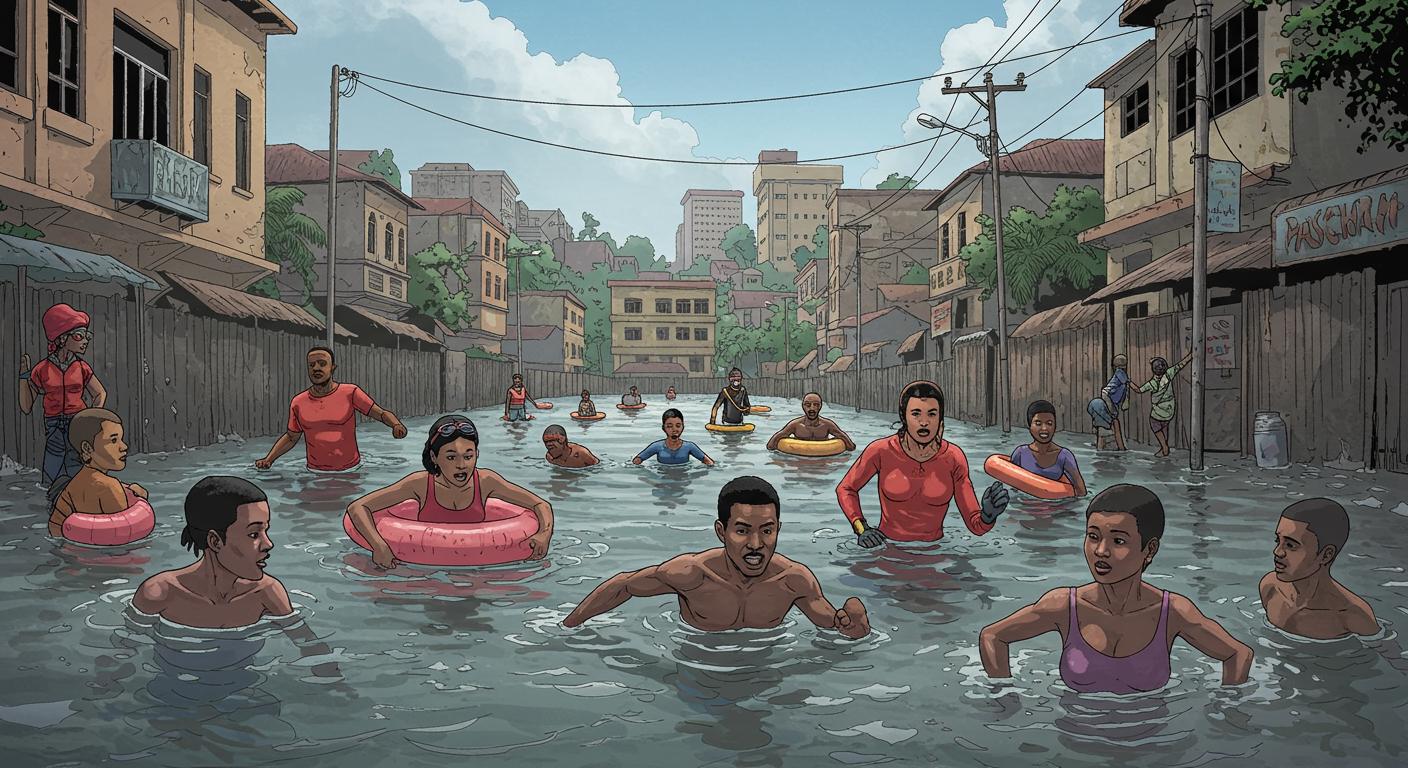If you ever wondered what it looks like when official flood prevention advice meets a shrug and a hopeful splash, look no further than Kampala this week. In a city where flash floods regularly take residents by surprise, the Ministry of Works and Transport has delivered a solution that is—let’s say—direct: learn to swim. Apparently, the days of sandbags and drainage maps have been replaced by backstrokes and butterfly kicks.
Sink or Swim, Courtesy of Official Policy
According to Daily Monitor, Dr. Charles Luzige, assistant commissioner for Maritime Monitoring, advised ahead of World Drowning Prevention Day that “residents need to learn how to swim,” emphasizing the skill as “the last resort when all else fails.” The outlet details that while drainage improvements are being made in notorious hotspots like Clock Tower and Meat Packers, and a network of search and rescue centers is being established across the country, personal preparedness—meaning, yes, basic aquatic competence—has become a stated government priority.
Grouped in the same report, Dr. Frederick Oporia from Makerere University’s Trauma and Injury Control Centre highlighted a quietly escalating public health crisis. Oporia explained that drowning “has quietly emerged as one of the top three causes of death in Sub-Saharan Africa over the past three years, alongside malaria and HIV/AIDS.” Citing a 2021 study, Daily Monitor confirms that 3,500 drowning deaths were recorded across 74 Ugandan districts in just two and a half years, working out to an average of over 1,400 deaths per year—or about eight people every single day.
Further underlining the point, Uzalendo News reports Luzige reiterated swimming is “not just a sport, it’s a survival skill, especially when every other safeguard fails.” The outlet groups their coverage around the dual approach: on one hand, infrastructural drainage projects and new rescue hubs supervised from Entebbe; on the other, appeals for individuals to take responsibility for their own safety, given the unpredictability of urban flooding in places like Kampala.
Both sources point to recent events that drove the message home: in March 2025, at least seven residents lost their lives in Kampala after flash floods. The reporting documents tragic consequences,“including residents falling into open drainage channels during heavy rains,” reflecting how the infrastructure still lags far behind urban growth. Daily Monitor spells out that people must “stay alert to weather forecasts and take personal responsibility for water safety.”
From Urban Plan to Swimming Lesson
The city’s solutions are not entirely limited to hopeful swimming strokes. As Uzalendo News recounts, Uganda is setting up search and rescue centers in high-risk districts (Panyimur, Kaisotonya, Lake Kyoga), targeting especially vulnerable zones like Masaka, Mayuge, Kyotera, Soroti, Rakai, and Serere. All are mapped as hotspots by the national drowning risk assessment referenced in both news outlets.
Still, teaching the dog paddle remains a centerpiece. Both Uzalendo News and Daily Monitor describe health officials and non-governmental advocates (including Mr. Humphrey Nabimanya, CEO of Reach A Hand Uganda) contending that swimming could dramatically reduce the tragic toll. “Drowning is a preventable tragedy, but we need more awareness. Teaching people how to swim could save countless lives,” Nabimanya stressed in the Daily Monitor report.
It almost reads like the punchline from a particularly dry municipal handbook: “In the event of flooding, proceed calmly to the nearest swimming pool.” Anyone unfamiliar with urban Uganda might be tempted to find a bitter irony here. But as both outlets document the heartbreak of families and the frequency of deadly accidents, the recommendation seems less absurd and more an acknowledgment of who’s left treading water when the storm drains overflow.
Flood Management: The Deep End
Broadly, the reporting from both outlets reflects a pattern not just unique to Kampala, but familiar to growing cities everywhere: when infrastructure strains under the weight of both rapid expansion and a busily shifting climate, adaptation becomes deeply personal.
The practical message is reinforced throughout Uzalendo News’s account: while “government interventions to address flooding are ongoing,” progress is slow and residents must look to their own skills—ideally before the next flash flood turns a street into an unintended river. As Daily Monitor further notes, drowning deaths are frequently silent, the kind of disaster that rarely trends until it’s literally overflowing.
Is it a sign of creative resilience—or just quiet surrender to limited budgets and perpetual construction? Perhaps a little of both, though it’s rare to see official guidance so candidly admit that, until help arrives, the city’s best defense is a citizenry that can tread water.
Paddling Forward
As Kampala marks World Drowning Prevention Day, the combined reporting offers a lesson not easily dismissed: from search and rescue hubs to earnest pleas for everyone to learn to swim, the city’s official flood management toolkit is equal parts whistle, megaphone, and breaststroke. On the one hand, the government is investing in infrastructure, mapping out rescue centers, and urging residents to stay alert. On the other, it’s making clear that “personal responsibility” now includes being able to navigate the nearest flooded junction with something other than desperate flailing.
You have to wonder—if climate unpredictability keeps ratcheting up, will urban survival someday require swimming tests alongside driver’s licenses? Or is this just one more odd twist in our collective attempts to keep heads above water—sometimes literally? There’s a distinct, quietly bizarre simplicity in Kampala’s approach, perhaps best summed up like a citywide inside joke: If you want to make it through the rainy season, pack your raincoat, keep an umbrella handy, and—who knows—those childhood swimming lessons may turn out to be the most valuable urban skill of all.







